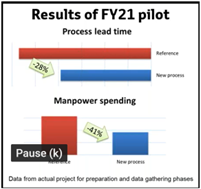Systems Thinking and Product Lifecycle Management (PLM) platforms – do the two converge on measurable benefits for your engineering teams? We have the answer, and it is a resounding yes! Here is the story....
First, let’s discuss ‘talking the talk.’ Back in the year 2018, I attended daily sessions of a Systems Thinking Roundtable at the INCOSE IS (International Council on Systems Engineering) conference in Washington D.C. The sessions were chaired by Dr. Cecilia Haskins of the Norwegian University of Science and Technology. One of the participants prepared a single Systems Thinking related question or idea for participants to evaluate, and each participant had a set length of time to discuss it. This was clearly about talking the talk, but it did require a firm commitment on the part of the participants to show up at 7:00 AM (sharp!), to express themselves within the allocated time (clocked!), and be willing to lead the next day’s session. These seemingly minor commitments were a key part of the exercise because they underscored the fact that ideas need people, processes, and discipline to become useful. These were open subjects and relaxed conversations, just a food for thought without a consequence. But was it?
Recently, I was listening to a webinar titled How Electrification is Transforming PLM Strategies. It was hosted by John MacKrell, Chairman, CIMdata. What I found interesting was that John presented a very coherent message touching on many Systems Thinking themes discussed randomly at the INCOSE roundtable but since organized into a coherent perspective. The core message was that rising product complexities (like vehicle electrification) create significant product opportunities, but that governing the underlying design process effectively requires Systems Thinking with a PLM platform-managed digital thread across the product lifecycle. And that the fundamental shift in thinking requires leading with system views as opposed to BOM (Bill of Materials) views. Note that I focused on the system views as opposed to system models because those views in context are what the rest of the organization benefits from. This means extending the digital thread to incorporate design intent that allows users to understand why things are designed in a specific way. Still talking the talk but now in the context of complexity and digital transformation. So, where’s the walk?
Not long ago there was a Rev-Sim (Revolution in simulation) sponsored webinar titled Development of a flexible digital thread for managing system performance simulation at Toyota Motor Europe. The Toyota Motor Europe (TME) portion was hosted by Ernesto Mottola, PhD., TME’s Vehicle Performance Engineering. The overarching message was that a digital thread is essential for enabling collaboration and optimization and that it is all about “connecting data=connecting processes=connecting people” in a Systems Thinking environment. What is unique about TME’s story is that it chose to start with the digital transformation of the design exploration space for a future electric car as opposed the actual design process of a specific product. It did that by creating a tool-agnostic digital thread to trace and manage individual sub-elements and sub-systems of a future electric car. This involved a system-centric approach to capturing 150% of the architectural structures of mechanical car platforms, including related variants, without the use of formal MBSE (model-based systems engineering) modeling tools like SysML language. This allows them to trace any parameter driven changes to these models as an input to the simulation with significantly reduced engineering effort. You can find out more about it here.

Fig. 1 TME’s reported benefits from the digital transformation of the engineering models
The webinar explains how this first phase is enabling TME to focus on democratizing and automating simulation by automatically generating simulation models. This means that the tool-agnostic digital thread will incorporate Simulation Process Data Management (SPDM) just the way it incorporated the sub-system models. One of the follow-up questions from the webinar’s audience was why TME is focused on organizing the fundamental engineering data instead of a specific product design process. According to Ernesto it is because you must first understand the fundamental underlying problem before addressing the higher-level design issue. TME is clearly walking the walk and I can’t wait for the next webinar that features the latest results!
Conclusions? Enabling free flowing but structured discussion of the basic Systems Thinking tenants like the Cecilia Haskins INCOSE roundtable allows individuals and teams to explore fundamental issues that should be addressed by every engineering organization. With that understanding, one can subsequently develop a unified vision of what a Systems Thinking driven digital transformation should be, given the emerging product complexities and new market opportunities as John MacKrell did. And then using that vision to enable visionaries within your organization to take risks with Systems Thinking and digital transformation. This approach is bound to produce huge benefits like those demonstrated by Ernesto Mottola.
So, there you have it. Systems Thinking and PLM platforms do converge … but it is a long journey that starts by connecting data=connecting processes=connecting people who first talk the talk and then walk the walk.
Learn more about Aras Enterprise SaaS and the benefits of Systems Thinking.

